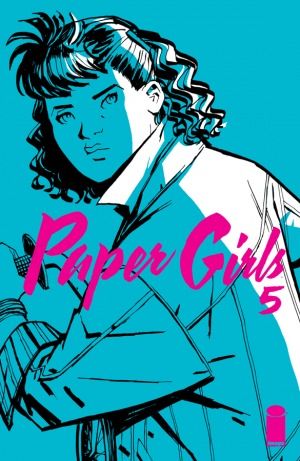Brian K. Vaughan and Cliff Chiang's "Paper Girls" #5 solves one crisis before throwing the girls into a new kind of danger. The pacing of "Paper Girls" has been exciting, but the constant running around also feels episodic at this point. The girls and the reader barely have time to catch their breath before something else is thrown in. In other words, there aren't enough slow moments to make the fast moments meaningful. Chiang's clean artwork keeps the transitions clear, but the overall plot feels more confusing.
Chiang has strong dramatic flair and the second page has an enjoyable visual jolt for Erin's injury. Vaughan's extended Apple gag is still amusing, but the stakes and the motivations of the characters aren't as clear as they should be this far into the series. Chiang's facial expressions are at their strongest when Erin is crying, but this is the only scene in which he gets to go beyond the superficial.
Characterization has stalled in favor of plotting. While Erin and the other girls are likable and plucky as ever, they're reactive more than active. The Western-style stand-off in the woods is exciting throughout due to Chiang's panel composition, but the resolution is predictable. Cardinal's English sounds like a bad combination of an overdone Irish accent, Romance languages and broken English. The use of pictograms to indicate a foreign language also still feels flashy. It adds mood and weirdness, but it's also too distracting without serving any other purpose than reinforcing Otherness, just like Cardinal's accent. However, her dinosaur looks fantastic, especially the head and wings. Chiang's technique of segregated thin texture lines within thick outlines looks especially good here and for the interior of Heck and Naldo's spaceship. His backgrounds are three-dimensional without ever feeling cluttered. Wilson's coloring has attractive hue choices, especially the pinks and yellows, but the scenes in the woods and the basement are too dominated by unimaginative blue and purples.
Erin's dream sequence feels disconnected from the rest of the story, but it reinforces her coming of age and the theme of youth vs. elders. The visual revelation of what the Grand Father has done to some missing people is like something out of "Doctor Who." While it's zany, it's not believable and thus lowers the stakes. It also shortchanges the villains on character development by having them engage in such over-the-top shenanigans, especially after their opponents were redeemed so dramatically in the opening scenes of "Paper Girls" #5.
The ending cliffhanger has strong pacing, but the twist doesn't have its full intended shock value because what occurs is commonplace in time travel stories.
Chiang's artwork is still a draw, especially in the dramatic moments that call for some visual spectacle, but "Paper Girls" #5 is showing the strain of a series that has been guilty of focusing too much on concept over emotional depth and characterization. The next arc may be better once the girls must deal with their new setting together.

